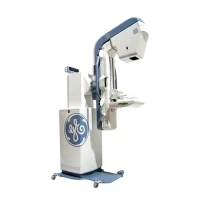
GE Alpha ST Mammography Machine
The GE Alpha ST Mammography Machine is a sophisticated system designed for high-quality breast imaging to aid in the early detection and diagnosis of breast cancer. It combines advanced technology with user-friendly features to provide clear and precise mammographic images. Here’s an overview of its key features, operation, and maintenance tips:
Key Features:
1. High-Resolution Imaging:
- Digital Mammography: Provides high-resolution digital images with enhanced clarity and contrast for better visualization of breast tissues.
- Advanced Detector Technology: Utilizes a state-of-the-art flat-panel detector or other advanced imaging technology to capture detailed images.
2. Image Processing and Analysis:
- Automated Image Processing: Includes software for automatic image processing, enhancement, and analysis to improve diagnostic accuracy.
- CAD Integration: May support computer-aided detection (CAD) to assist in identifying potential abnormalities.
3. Patient Comfort and Safety:
- Ergonomic Design: Designed with features to improve patient comfort, such as adjustable compression and positioning capabilities.
- Low Radiation Dose: Incorporates dose-reduction technology to minimize radiation exposure while maintaining high image quality.
4. User-Friendly Interface:
- Control Console: Features an intuitive control console for easy operation, including setting imaging parameters and reviewing images.
- Advanced Software: Includes software for image review, storage, and integration with hospital information systems (HIS) or picture archiving and communication systems (PACS).
5. Versatility:
- Imaging Options: Supports various mammography views and techniques, including standard 2D imaging and, in some models, 3D tomosynthesis (if available).
Operation:
1. Patient Preparation:
- Positioning: Position the patient correctly on the imaging platform. Ensure the breast is properly aligned for optimal imaging.
- Compression: Adjust the compression paddle to achieve adequate compression of the breast, which helps improve image quality and reduce motion artifacts.
2. Image Acquisition:
- Select Protocol: Choose the appropriate imaging protocol from the control console or software interface. This may include selecting specific views or techniques.
- Configure Settings: Adjust exposure parameters and other settings as needed to suit the patient and imaging requirements.
- Capture Images: Initiate the imaging process. The machine will capture and process the mammographic images.
3. Image Review and Management:
- Analyze Images: Use the control console or workstation to review the images. Utilize software tools for enhancement, measurements, and annotations.
- Save and Transfer: Save the images and patient data. Transfer the images to PACS or other storage systems as required.
Maintenance Tips:
1. Regular Cleaning:
- Detector and Compression Paddle: Clean the imaging detector and compression paddle regularly to maintain hygiene and ensure clear imaging.
- X-Ray Tube: Keep the X-ray tube and surrounding area clean to ensure optimal performance.
2. Calibration:
- Routine Calibration: Perform regular calibration and quality control checks as per the manufacturer’s guidelines to ensure accurate image acquisition.
- Software Updates: Keep the imaging software updated for improved functionality and performance.
3. Technical Support:
- Service Agreements: Consider a service agreement with GE Healthcare for regular maintenance and technical support.
- Troubleshooting: Refer to the user manual for troubleshooting guidance or contact technical support for assistance with operational issues.
4. Preventive Maintenance:
- Scheduled Maintenance: Follow the preventive maintenance schedule recommended by the manufacturer to ensure the machine’s longevity and reliability.
